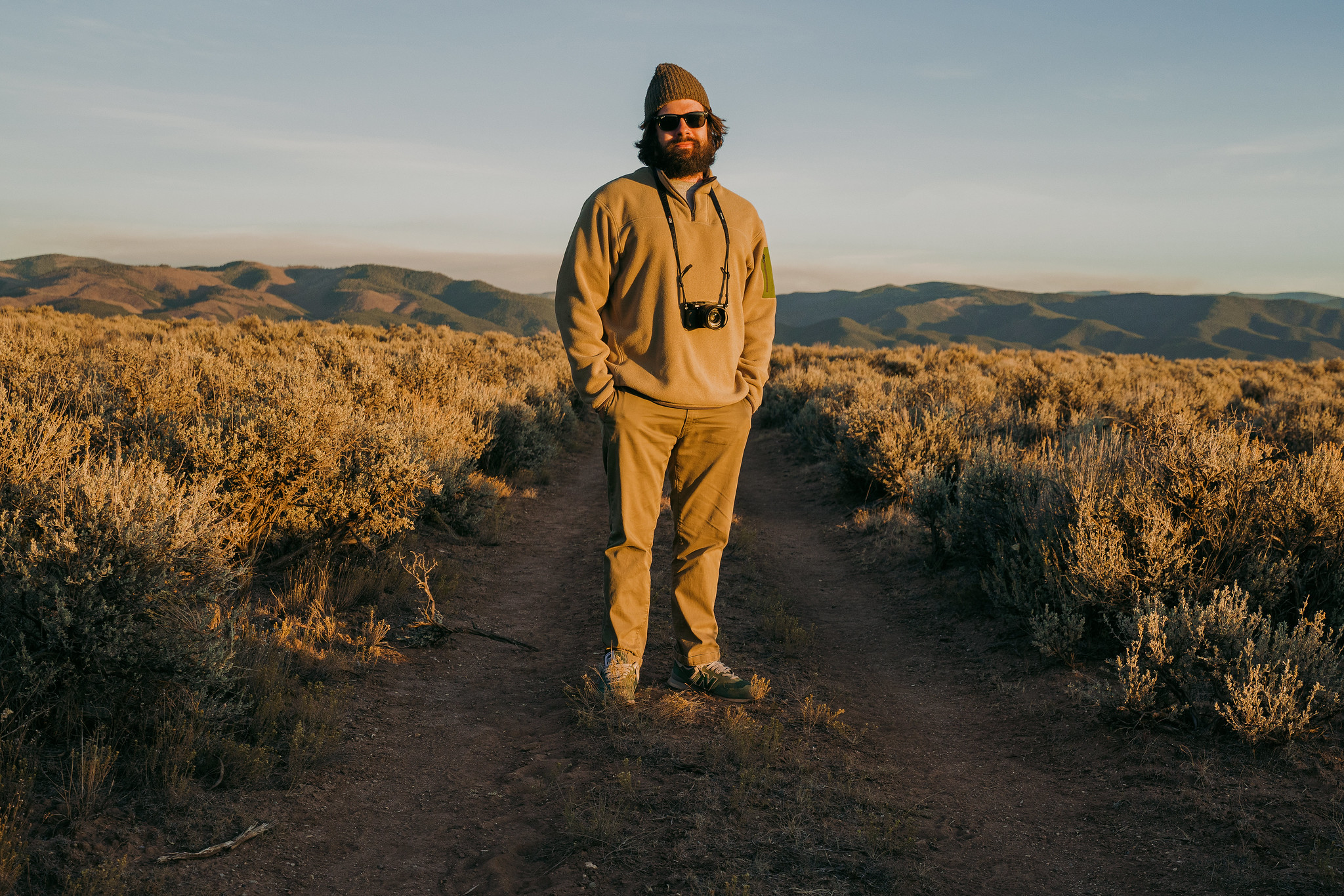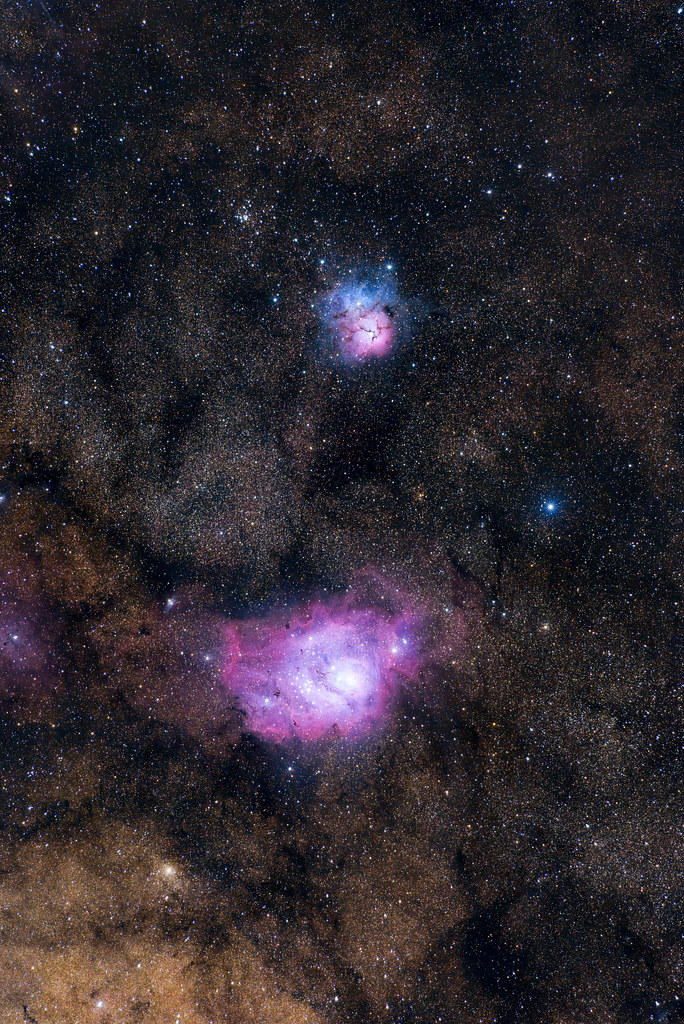With April 8th’s total solar eclipse quickly approaching, we want to continue featuring the amazing astrophotography community on Flickr. We recently highlighted several astrophotography Flickr groups. If you didn’t get a chance to check those out, you can read about them in our recent blog post. Today, we want to introduce you to Mike Hawkins, a talented photographer who has photographed many different genres of photography over the years, and has an amazing gift for capturing astrophotography. He recently walked us through his process in capturing this stunning photo, “The Lagoon and Trifid Nebulas | M8 and M20” for this installment of 16 Questions about 1 Photo. Enjoy!
1. Please introduce yourself. Who are you? What do you do?
My name is Michael Hawkins. I live in the mountains of northern New Mexico, and I enjoy skiing, golf, photography, astronomy, and small-town life. For my day job, I work in marketing for a ski resort (yes, we have great skiing in New Mexico!), so I get to bring a camera with me to work every day!
2. How long have you been into photography, and what drew you to it?
I first picked up a camera in my late teens, and I’ve been a photographer (both professional and not) for nearly twenty years. I enjoy documenting my life, the people I’ve met, and the landscapes I’ve seen along the way via old manual-focus lenses. Photography allows the two sides of my brain to meet in the middle, and it just brings me a lot of joy.
3. In one sentence, please describe what you captured in this shot.
I captured the Lagoon and Trifid Nebulae, which are located in the southern skies in the bands of our Milky Way Galaxy, in the constellation Sagittarius. The Lagoon Nebula is visible to the naked eye, and the Trifid Nebula can be found with binoculars.
4. What style of photography would you describe this as and do you typically take photographs in this style?
This style of photography is known as astrophotography, and it’s one of the many forms of photography that I enjoy. I take astrophotos as often as the weather allows.
5. When and where was this photo taken?
This shot was taken in my backyard near Taos, New Mexico, which has Bortle 3 skies. It was taken in the late summer when these objects can be seen near the center of our Milky Way Galaxy.
6. Was anyone with you when you took this photo?
My dog Stella kept me company overnight, and my partner Kelly wasn’t far away; she was just fast asleep in bed.
7. What equipment (hardware and software) did you use?
Equipment: Celestron CGEM Mount, Nikon 500mm f/4 P AI-S – shot at f/5.6, Sony a7RIII (unmodified), Altair 60mm Guide scope, GPCAM2 Mono Camera
Software: SharpCap, PHD2, PixInsight Lightroom, Photoshop
8. What drew you to take this photo?
I’ve been into astronomy for years, so I bought a telescope, knowing I’d eventually want to learn to do astrophotography. Truthfully, it always felt overwhelming. During the COVID quarantines of 2020, I (like a lot of people) had a ton of extra time at home and decided that was the moment to dive in finally. I bought autoguiding gear and taught myself how to take and process long exposures of the night sky.
9. How many attempts did it take to get this shot? How long did it take you to get one that you were satisfied with?
While I’ve tried and failed many times with astrophotography, this image was captured on the first try.
10. Did you edit this photo?
Oh yes! This image is heavily processed, as any astrophoto is. To achieve photos like these, you need to take many long exposures and stack them together to reduce the signal-to-noise ratio so you can stretch out the image and bring out the faint light. I feel that astrophotography is more data acquisition and data manipulation than “real” photography.
11. What encouraged you to share this photo online and with others?
I’ve loved sharing my work on Flickr since 2007. It’s where I post everything. I do it both for archival purposes and, well…because I like getting attention for my work!
12. Did you learn anything in the process of taking, editing, or sharing this photo?
I learned a lot! For the bulk of the processing, I used a program called PixInsight, which is designed specifically for astrophotography. For a long time, I felt that I could get “good enough” results using some (really great) free tools. However, spending time watching YouTube tutorials and following along has taught me so much about PixInsight, which I feel has a STEEP learning curve…but worth it for the excellent results.
13. Do you remember what you had for breakfast (or lunch or dinner) the day you took this photo?
I ate Madras Chicken for dinner, one of many great recipes from a “Half Baked Harvest” cookbook that I borrowed from the local library.
14. What would you like people to take away from this photo?
I hope that this image inspires people to learn more about space and our universe in general (it’s all REALLY cool) and that it’s worth taking the time to look up at the night sky. The light from the Lagoon Nebula took ~5,000 years to travel to my camera sensor and ~9,000 years for the smaller Trifid Nebula! If you want to learn how to take astrophotos yourself, there are many great and free resources online.
15. Is there any feedback that you’d like to get on this shot?
I’m open to hearing feedback from other astrophotographers. I know the next step in upgrading my equipment is to purchase a monocamera and filters (to pull out even more detail), but I do enjoy using my regular old Sony camera and adapted vintage lenses for astrophotography for now!
16. How can anyone reading this, support your work?
They can follow me here on Flickr, check our my website or on Instagram as @mikehawkins, even though I try to spend as little time on there as possible! I enjoy Flickr the most and engage with more photographers and their photographs right here.

Mike Hawkins is a lifelong photographer who enjoys the challenge of shooting many genres of photography. These days he is most interested in astrophotography, ski photography, and the scenes of daily life.
He uses manual vintage lenses adapted to function on modern digital cameras. Vintage, manual lenses force him to slow down figuratively and literally to focus on what he is capturing. Older lenses often produce images full of unique character not found in the clinically sharp automatic lenses made today.
Not a Flickr member yet? Sign up today to join our community of photographers and find your inspiration.
